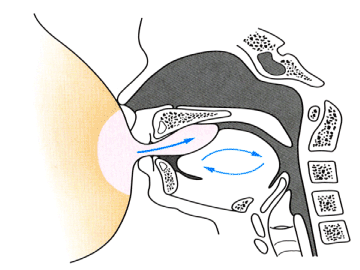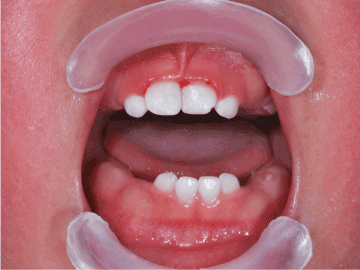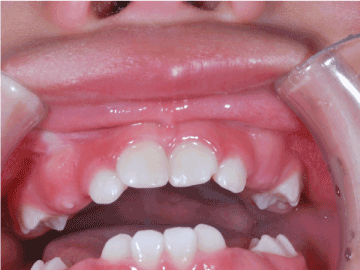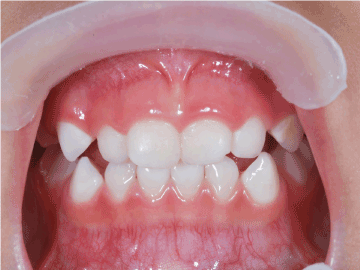Development of sucking and mastication from birth to deciduous dentition period varies along with eruption of teeth. I have tried to interpret the changes in this paper.
Sucking is induced by several primitive reflexes. That is, what-is-it reflex to seek for the nipple (rooting reflex) and catch the nipple (captive reflex) with lips, and the most direct one, sucking reflex to suck from the mother's nipple with a fixed rhythm. Tongue thrusting reflex to push solid matters out of the mouth with the tongue may be understood as a reflex in order to focus on sucking because baby food is started at around a period (6 to 7 months old) when this reflex disappears. The sucking is achieved by movements according to their, each rhythm of the muscles of the jaws, tongue and face existing separately at a part of the motor trigeminal nucleus, hypoglossal nerve nucleus and facial nerve nucleus in the brain stem, respectively [1].
Secretion of milk is promoted by such activities to hold the nipple in the mouth just like taking a bite and pull into the palatal fossa, wrap the nipple with the tongue and squeeze it from the isola to the tip of the nipple by to-and-fro movement. With the Mt. Fuji-shaped lips due to the rudimentary orbicular muscle of the mouth, swallowing of milk is performed without shutting the lips (Figure 1).

Figure 1. Suckling of breast milk - Promote milk secretion by to-and-fro movement of the tongue (Takahide Maeda, et al.: Children's oral science).
In case of poor sucking, its causes relating to the oral cavity include sublingual ulceration (Riga-Fede) by congenital teeth and ankyloglossia. Ankyloglossia is disadvantageous for sucking because of restricted to-and-fro movement of the tongue but it is possible to provide milk by a required amount by making the baby hold the nipple deep enough in the mouth.
Conversion from sucking to mastication is a characteristic change in eating behavior in mammal including human and it is believed that eruption of teeth and associated stimulation from surrounding tissue of the periodontal membrane are related with initiation of mastication [2]. In spite of the fact that, some of ungulates have baby teeth erupted already at the time of birth and guinea pigs are born with completed permanent teeth, however, eating behavior of these animals is converted to mastication after a fixed period of sucking since birth [3]. While eruption of deciduous teeth begins six to seven months after birth in case of human, it is likely that induction of mastication has been initiated by the central nervous system before teething in consideration of a behavior to crush food with the tongue and the alveolar ridge observed periodically before teething (about 5 months old). Subsequently, muscular activities of the jaws, tongue and face are established as a coordinated motion with the same rhythm by a stronger sense centrally transferred from periphery in response to eruption of teeth.
Different from sucking, mastication is a function acquired by learning and established by acquiring a series of functions in order such as swallowing with lips closed, crushing with the tongue and alveolar ridge, and crunching with teeth. Meanwhile, various matters are learned such as difference in food properties, how to transfer foods in the oral cavity, cutting, sensitivity for water amount and forming of food bolus. As Illingworth, et al. [4] call this period as critical period of mastication motion, it is understood that subsequent establishment of systemic mastication may be affected if this process was not gone through by some influence. A case has been reported that a newborn infant with ectodermal dysplasia, which was close to complete anodontia, was not able to masticate even after wearing a deciduous teeth denture [5].
During early weaning period (5 to 6 months old), newborn babies start adult-style swallowing by moving the tongue back and forth to swallow thick weaning food (bread porridge, etc.) by drawing down the upper lip to close the lips.
During middle weaning period (7 to 8 months old), they start to crush foods by the tongue and the palate adding up-and-down movement to the tongue. Weaning food becomes of a hardness which can be crushed with the tongue.
During late weaning period (9 to 12 months old), movement of the lower jaw, which had been lack of organization, starts to be controlled when four anterior teeth have achieved occlusion by eruption of deciduous incisors (A) followed by lateral incisors (B) (Figure 2). With horizontal movement added to the tongue, foods are moved to the alveolar ridge to be eaten. Weaning is completed at around one year after birth.

Figure 2. Eruption of A and B on the both jaws (9 to 11 months old) - Initiation of eating with the alveolar ridge.
Then, occlusion of the upper and lower jaws becomes stable by subsequent eruption of first primary molar (D) before the deciduous cuspid eruptions (C) (Figure 3). Occlusion of D is a key point for mastication during early deciduous dentition period. With totally 16 teeth erupted in place at upper and lower as well as on the left and right positions, A, B, C, and D, mastication corresponding to the kinds and properties of foods becomes possible by the age one and half (Figure 4).

Figure 3. Eruption of A, B and D on the both jaws (16 months old) - Become to eat by crushing with teeth upon eruption of D.

Figure 4. Smooth mastication is achieved by eruption of A, B, C and D on the both jaws (19 months old).
By the age of three, deciduous dentition is completed by eruption of the second primary molar making more delicate mastication possible. Along with remarkable growth in both height and weight during the age from three to six, amount of exercise and required number of calories also increase. However, few change is observed in the oral cavity during the three years. By making full use of the deciduous dentition and the tongue, mastication is performed intently until the first permanent molar erupts. Mastication efficiency is further improved when first permanent molars become to occlude at the age of six resulting in establishment of mastication corresponding to growth during school child age.
Temporomandibular joint also grows along with development of occlusion within the oral cavity. Temporomandibular joint before deciduous teeth eruption is flat just like a dish making it easier to adapt to to-and-fro movement of the lower jaw at the time of sucking. Since the mandibular movement becomes to be regulated at around age of three when deciduous occlusion is completed, morphology of center of the mandibular condyle begins to protrude corresponding to the deepened joint fossa.
Thus, mastication is gradually established while being involved in occlusion and growth of temporomandibular joint, development of other oral functions, i.e. development of gusutatory sense, and growth of salivary glands which stimulate secretion of saliva.
- Sameroff AJ (1968) The components of sucking in the human newborn. J Exp Child Psychol 6: 607-623. [Crossref]
- Moyers RE (1973) Handbook of orthodontics. 3rd ed. Year Book Medical, Chicago.
- Ainamo J (1971) Prenatal occlusal wear in guinea pig molars. Scand J Dent Res 79: 69-71. [Crossref]
- Illingworth RS, Lister J (1964) The critical or sensitive period, with special reference to certain feeding problems in infants and children. J Pediatr 65: 839-848. [Crossref]
- Shiere FR, Manly RS (1952) The effect of the changing dentition on masticatory function. J Dent Res 31: 526-534. [Crossref]
2021 Copyright OAT. All rights reserv




